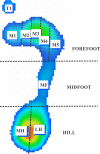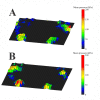Changes in plantar load distribution in legally blind subjects
- PMID: 33857169
- PMCID: PMC8049300
- DOI: 10.1371/journal.pone.0249467
Changes in plantar load distribution in legally blind subjects
Abstract
We investigated the impact of visual impairment on balance control. We measured the center of pressure (COP) between the two feet and plantar surface pressures on each foot in 18 normal-sighted participants and compared their data with measures from 18 legally blind participants, either acquired or congenital. Pressures were measured in open- and closed-eye conditions using a baropodometric resistive plate. In the eyes-open condition, there were no differences between the sighted and legally blind groups in COP displacement. However, participants with visual loss had significantly increased pressures in two metatarsal regions (M1 and M2 zones) of the plantar surface in both viewing conditions (p < 0.05). The differences in pressure measures between the normally sighted and legally blind groups could be attributed mainly to the subgroup of subjects with acquired impairment. Our findings suggest that subjects with visual impairment present increased metatarsal pressures (i.e. forefoot), not yet associated to anterior displacement of COP or impaired balance control.
Conflict of interest statement
The authors have declared that no competing interests exist.
Figures



References
-
- Oie KS, Kiemel T, Jeka JJ. Multisensory fusion: simultaneous re-weighting of vision and touch for the control of human posture. Brain Res Cogn. 2002; 14(1): 164–76. - PubMed
Publication types
MeSH terms
LinkOut - more resources
Full Text Sources
Other Literature Sources
Medical

